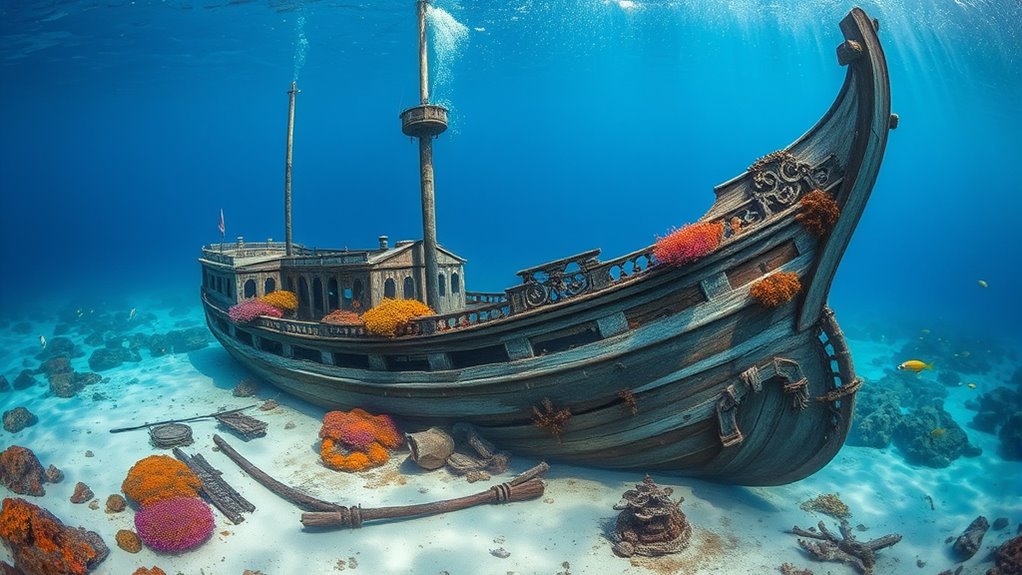You’ll find that this century-old shipwreck has been remarkably preserved underwater, thanks to natural environmental factors like cold, low-oxygen conditions, and mineral-rich waters that inhibit decay. Researchers and explorers recently uncovered this vessel, which offers a rare glimpse into maritime history, construction techniques, and trade routes. This discovery highlights how underwater environments can act as natural time capsules. If you want to explore more about this incredible find, there’s plenty of fascinating details to uncover.
Key Takeaways
- The shipwreck, over a century old, was recently uncovered by explorers, revealing well-preserved wooden and metal structures.
- Underwater conditions like low oxygen and mineral-rich waters naturally slowed decay, aiding preservation.
- Advanced techniques such as sonar mapping and remote-operated vehicles facilitated site discovery and documentation.
- Artifacts like cargo and personal belongings were recovered and undergo conservation to prevent deterioration.
- The find offers valuable insights into historical shipbuilding, trade routes, and maritime life, emphasizing ongoing research importance.

A team of explorers recently uncovered a shipwreck dating back over a century, revealing a rare glimpse into maritime history. As you dive into this discovery, you realize how essential marine archaeology is in unlocking the stories hidden beneath the waves. This field allows you to explore the past through meticulously studying shipwrecks like this one, providing insights into ancient construction techniques, trade routes, and daily life aboard vessels from a bygone era. The preservation of such wrecks underwater plays a key role because the aquatic environment naturally slows down decay, helping these artifacts remain remarkably intact over the decades. Biodiversity in the marine environment also contributes to the preservation process, as diverse underwater ecosystems can help protect wreck sites from harmful human activities. You’re struck by how underwater preservation works as a natural safeguard. The cold, low-oxygen conditions and mineral-rich waters create an environment where wood, metal, and other materials resist corrosion far better than they would on land. This shipwreck, for example, still boasts its wooden hull, cargo holds, and even personal belongings, offering a detailed snapshot of the time. Your team carefully documents every detail, knowing that each artifact contributes to a broader understanding of maritime history. They use advanced tools like remote-operated vehicles and sonar mapping to chart the site without disturbing its fragile state, maintaining the integrity of the wreck for future study. Additionally, the preservation techniques employed by conservationists are crucial to ensure that artifacts survive long-term after recovery, which is essential for ongoing research. Conservation efforts are often supported by innovative methods that help stabilize artifacts in challenging underwater conditions. You learn that proper artifact stabilization is vital for preventing deterioration once artifacts are exposed to different environments. As you observe the site, you’re reminded that marine archaeology isn’t just about uncovering relics; it’s about conserving them for the long term. Underwater preservation involves delicate techniques to prevent deterioration once the wreck is exposed to air and different chemical conditions. Your team employs specialized conservation methods such as controlled drying and chemical treatments to stabilize artifacts before they’re moved to museums. This meticulous process guarantees that these pieces of history won’t be lost to neglect or environmental factors. You also realize that the discovery highlights the importance of ongoing research and collaboration among scientists, historians, and conservationists worldwide. Each new find adds valuable data, helping reconstruct historical narratives and understand maritime trade, migration, and cultural exchange. The shipwreck’s state of preservation underscores how natural underwater conditions can be allies in archaeology, transforming what might seem like a simple sunken vessel into a time capsule waiting to be explored. The natural underwater conditions act as an unexpected preservation aid, highlighting the importance of environment in conservation efforts. In the end, you see how this discovery isn’t just about uncovering a ship—it’s about conserving a piece of history that connects the past to the present. Thanks to marine archaeology and underwater preservation, what was once lost beneath the waves now offers a vivid story for future generations to learn from and admire.
Frequently Asked Questions
What Was the Ship’s Original Purpose or Cargo?
You might wonder about the ship’s original purpose or cargo. Its cargo was likely valuable, possibly trade goods or resources relevant to its era, giving it significant historical importance. This cargo helps you understand the ship’s role in trade routes and economic exchanges during its time. Knowing its purpose enriches its historical significance, revealing insights into maritime history and the types of goods exchanged centuries ago.
Are There Any Human Remains or Artifacts Inside the Wreck?
You might wonder if there are any human remains or artifacts inside the wreck. In many cases, explorations reveal artifacts well-preserved due to the underwater environment. Human remains are rare but possible, depending on how the ship sank and its location. The preservation of artifacts inside the wreck offers valuable insights into the past, helping you understand the ship’s history and the lives of those who traveled aboard it.
How Deep Underwater Is the Shipwreck Located?
You wonder about the shipwreck’s depth underwater, and it’s fascinating. This site lies approximately 100 meters below the surface, making it a prime focus for marine biology and underwater archaeology. Such depth requires specialized equipment to explore safely. As you explore into the study, you’ll uncover how this environment preserves artifacts and offers insights into maritime history, highlighting the importance of advanced technology in underwater archaeology.
What Preservation Methods Are Used to Study the Wreck?
You use specialized preservation methods to study the wreck, focusing on underwater conservation and marine biota preservation. Techniques include applying controlled environmental conditions, like low temperatures and oxygen levels, to prevent deterioration. Researchers also carefully document the site, avoiding damage from human activity. These methods make certain the ship remains intact for future study, helping you understand its historical significance while protecting the marine environment around it.
Will the Site Be Open for Public or Research Access?
You’ll be amazed to learn that the site might not be open to the public, as it’s protected for research permits and preservation efforts. This underwater marvel is so fragile that only authorized scientists with special museum access can explore it. While the public can’t visit directly, researchers work tirelessly to study and preserve it, ensuring its history remains safe for future generations.
Conclusion
As you stand before this astonishing relic, it’s hard not to feel like you’ve uncovered a treasure more valuable than all the gold in the world. This perfectly preserved shipwreck offers a rare glimpse into history that’s nearly as old as time itself. Thanks to your curiosity and courage, you’ve revealed a secret that’s been hidden beneath the waves for over a century. Truly, this discovery is a feat that’ll be remembered for generations to come.









